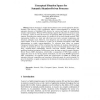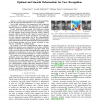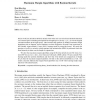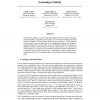303 search results - page 45 / 61 » Facial Expression Space Learning |
ESWS
2008
Springer
13 years 10 months ago
2008
Springer
Context-awareness is a highly desired feature across several application domains. Semantic Web Services (SWS) technologies address context-adaptation by enabling the automatic disc...
ICMI
2004
Springer
14 years 1 months ago
2004
Springer
Perhaps the most fundamental application of affective computing would be Human-Computer Interaction (HCI) in which the computer is able to detect and track the user’s affective ...
FGR
2011
IEEE
13 years 8 hour ago
2011
IEEE
— In this work, we present novel warping algorithms for full 2D pixel-grid deformations for face recognition. Due to high variation in face appearance, face recognition is consid...
COLT
2003
Springer
14 years 1 months ago
2003
Springer
Recent work has introduced Boolean kernels with which one can learn linear threshold functions over a feature space containing all conjunctions of length up to k (for any 1 ≤ k ...
ICASSP
2008
IEEE
14 years 3 months ago
2008
IEEE
This paper investigates a class of learning problems called learning satisfiability (LSAT) problems, where the goal is to learn a set in the input (feature) space that satisfies...




